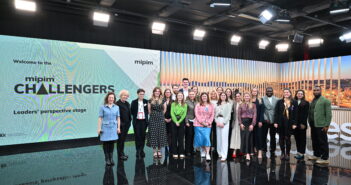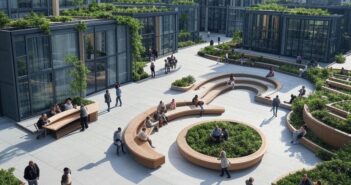How can we maximise the use of space; boost productivity; minimise environmental damage; and match, if not exceed, user requirements? All central questions to real estate.
A growing part of the answer lies in focussing on modern methods of construction (MMC), a catch-all term for improvements in construction processes and technologies, both on site and off.
Landsec is one of the first developers to take the full plunge into this new world, with The Forge in London’s Southwark district, a 139,000 sq ft/12,900m2 development aiming to be the UK’s first net zero carbon commercial building.
To help reach this aim, The Forge – which has received funding from Innovate UK, the UK’s innovation agency – is using an open-source P-DfMA, which is short for ‘platform design for manufacture and assembly’.

Here, we talk with Neil Pennell, head of design & innovation at Landsec, about using the ‘kit of parts’ solution built on a P-DfMA structural frame, and what the solution brings to the real estate industry.
What is P-DfMA? Will it lead to lots of buildings looking the same?
Neil Pennell: “P-DfMA takes the tried and tested principles of manufacturing and applies them to construction. In manufacturing, wide arrays of products are made from the same basic components using shared underlying structures.
“By working out the features of a building element, such as the structure, shared across different building types, it is possible to identify a set of standardised parts, such as beams, columns, connectors, slabs. This can then form the basis for the vast majority of construction projects.
“As with cars, the platform approach doesn’t mean all buildings will look the same, or deliver the same experience, but it does deliver significant benefits in design, supply, manufacturing and assembly.”
Will you be using P-DfMA across your portfolio?
NP: “Platform design and digital technology will revolutionise the construction of commercial buildings. It will make the process more productive, reduce time and cost, improve quality and decrease carbon emissions. Our goal at Landsec is to lead the market in the adoption of these new approaches.
Platform design and digital technology will revolutionise the construction of commercial buildings. It will make the process more productive, reduce time and cost, improve quality and decrease carbon emissions – Neil Pennell, Landsec
“Ultimately this approach will provide higher skilled jobs in the construction sector and enable us to deliver a greater number of efficiently delivered, sustainable spaces for our customers, helping us meet our target to be a net zero carbon business by 2030.”
How does this change the role of the architect & designers?
NP: “A platform approach frees up architects and designers from repetitive tasks. They can then devote their time, expertise and creativity to the areas where they will add the most value: to the design, life-cycle performance and placemaking impact.
All lessons learnt are fed back into future projects… drawing the world of construction into the virtuous cycle of progressive innovation – Neil Pennell, Landsec
“Designing with standard components allows for an increase in the use of digital design tools, allowing for the consideration of multiple design configurations to find optimal solutions.
“All lessons learnt are fed back into future projects, with components and processes being continually improved, drawing the world of construction into the virtuous cycle of progressive innovation.”
Is it significant that P-DfMA is open source, with the original source code available to all?
NP: “Platforms are not proprietary technology. The P-DfMA solution we are developing will be open source, encouraging the most widespread adoption together with shared learnings and improvements. It is about harnessing the creativity and power of collaboration.
“Widespread adoption will help grow the marketplace and create opportunities for new companies to enter the built environment sector, improving productivity, efficiency and competitiveness.
“Our USP does not lie in the processes and components which underpin the delivery of P-DfMA projects, but in the knowledge of how to apply these processes and components to drive business value and the supply chain delivery partnerships we create.”
How will this approach disrupt the built environment sector?
“Using this innovative approach exposes one of the most conservative and traditional sectors of our economy to the transformational power of the 4th industrial revolution; big data, AI, cloud computing, robotics, advanced manufacturing, and IoT,” adds Pennell.
Most of what is needed in terms of technology is available and ready to be used, but the industry needs to develop the skills to use the technology effectively and to invest in the manufacturing capability to deliver through using these new methods.
The ability for P-DfMA to unlock modern methods of construction is just the first step. We must also consider how the built environment performs throughout its life.
How does the platform work as a system?
The P-DfMA structural solution we are deploying at The Forge provides a standardised exoskeleton onto which other building components can be reliably and repeatably assembled – Pennell.
“Its design and delivery are underpinned by a digital ecosystem which when linked with offsite manufacturing capability enables a wider kit of parts and modern methods of construction to be integrated effectively into the delivery of the project.”
The results of Landsec’s P-DfMA trial
Landsec carried out a trial together with design practice Bryden Wood and offsite specialist Easi-Space to prototype a new building structure design. Compared with traditional construction methods, the P-DfMA trial revealed:
- 55% improvement in construction productivity
- 30% shortening of delivery times
- 33% reduction in costs
The resulting componentised solution uses less material, creates less waste and has an estimated 19.4% reduction in embodied carbon compared with an equivalent traditionally designed structure – Pennell
Call for alternative building materials to cut carbon
McKinsey identified the opportunity to bring change in 2017, with its report Reinventing Construction: A route to higher productivity, as mentioned by Guillaume Bazouin, head of open innovation & start-ups at Leonard, the VINCI Group’s foresight & innovation platform, in the MIPIM World Blog.
The McKinsey report estimated that moving to a manufacturing-style production system could boost productivity five to ten times for some parts of the industry. It identified “new technologies, materials and processes” as being among the key trends leading to a potential disruption of the industry.
In terms of materials, a current focus is on reducing the carbon footprint of concrete. Cement, a key component of concrete, is the world’s second most consumed product after drinking water, and in the industrial sector it produces the most CO2 emissions per dollar of revenue – followed by iron & steel.
More innovative approaches, such as new technologies and alternative building materials, will be indispensable to achieve carbon-reduction targets by 2050 – McKinsey
In the 2020 article Laying the Foundation for Zero Carbon Cement, McKinsey writes: “More innovative approaches, such as new technologies and alternative building materials, will therefore be indispensable to achieve carbon-reduction targets by 2050.”
While the use of concrete can be lowered by using hybrid materials such as timber and through digital platforms such as P-DfMA, the race is on to look for ways to reduce the carbon impact of cement, which accounts for around 7% of global CO2 emissions, much higher than for aviation. The key will be the ability to scale.
One start-up working in this field is Oxara, a spin-off from ETH Zürich, and a recipient earlier this year of funding from the European Union’s Horizon 2020 programme.
Oxara has developed a process that involves adding Oxacrete©, a non-toxic, mineral-based chemical, to excavated building material to produce cement-free concrete, or Cleancrete©.
This offers a “90 per cent carbon reduction and significant cost reduction compared with conventional concrete,” says Oxara founder Gnanli Landrou, who is in the Forbes Under 30 2019 list in Europe. Watch this space!



